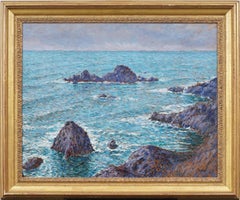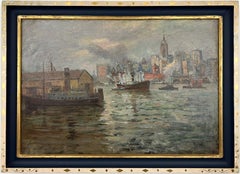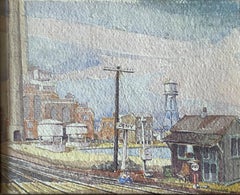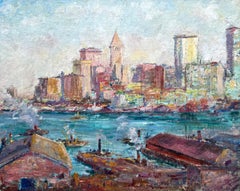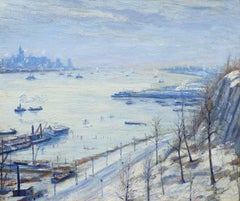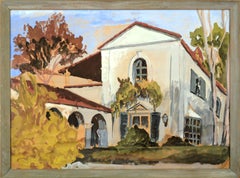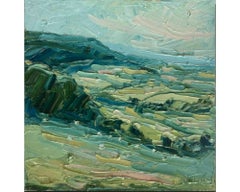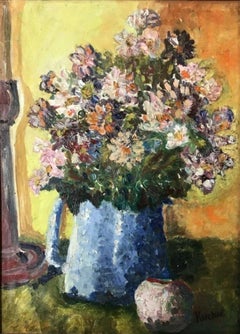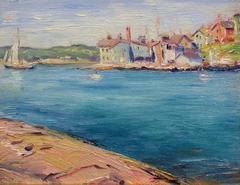Max Kuehne Paintings
American, 1880-1968
Born in Halle, Germany in 1880, Max Kuehne was a colorist who created cheerful landscapes that appear to be painted spontaneously and with freshness.
He studied with William Merritt Chase and Kenneth Hayes at the Chase School in New York. In 1910, he embarked on a bicycling trip, traveling through England, France, Germany, Holland and Belgium. To support this trip he did portrait commissions along the way.
When he returned to New York City, he set up a studio in Greenwich Village and was a student of Robert Henri from whom he learned a dark impressionist style. He also became close with such avant garde artists as Guy Pene du Bois, William Glackens, William Zorach and Maurice and Charles Prendergast, which also influenced his dark work including street scenes and docks in New York City. However, three years in Spain, and painting trips to Gloucester lightened his palette as did time in Paris where he was much influenced by the Fauves, Nabis, and decorative painters. By 1912 he was producing work that would make him known as a "colourist of great distinction" by producing "paintings full of sparkling sunlight."
He became a member of the artistic community later in Rockport, Massachusetts, with Gifford Beal, Leon Kroll, Paul Manship, Edward Hopper and Jonas Lie. Many of his finest paintings done later in his career are of the busy harbors and piers of Gloucester and Rockport.
His work was widely exhibited including the National Academy of Design, the Art Institute of Chicago, and the Carnegie Institute in Pittsburgh.to
2
2
1
1
2
Overall Width
to
Overall Height
to
6
2
1
1
4
1
6
2
1
1
1
6
5
3
3
2
10
781
715
711
692
6
6
Artist: Max Kuehne
Antique American Impressionist Summer Seascape Signed Framed Large Oil Painting
By Max Kuehne
Located in Buffalo, NY
Antique American impressionist Max Kuehne (1880 - 1968) seascape oil painting. Oil on board. Framed. Signed. In excellent original condition. Handsomely framed in a giltwood mol...
Category
1950s Impressionist Max Kuehne Paintings
Materials
Oil, Board
$10,200 Sale Price
20% Off
Provincetown
By Max Kuehne
Located in Milford, NH
A colorful impressionist coastal oil painting of Provincetown by German / American artist Max Kuehne (1880-1968). Kuehne was born in Halle, Germany, and emigrated to Flushing, New Y...
Category
Mid-20th Century American Impressionist Max Kuehne Paintings
Materials
Oil, Panel
$5,900
Brooklyn Bridge through the Clouds-Original New York 20th Century Oil Painting
By Max Kuehne
Located in Marco Island, FL
An atmospheric and impressionistic view of New York City's towering skyline with ships in the harbour on a misty day. This lovely painting is housed in a beautifully detailed artist...
Category
Early 20th Century American Impressionist Max Kuehne Paintings
Materials
Oil, Canvas
"Train Station, " Max Kuehne, Industrial City Scene, American Impressionism
By Max Kuehne
Located in New York, NY
Max Kuehne (1880 - 1968)
Train Station, circa 1910
Watercolor on paper
8 1/4 x 10 1/4 inches
Signed lower right
Provenance:
Private Collection, Illinois
Max Kuehne was born in Halle, Germany on November 7, 1880. During his adolescence the family immigrated to America and settled in Flushing, New York. As a young man, Max was active in rowing events, bicycle racing, swimming and sailing. After experimenting with various occupations, Kuehne decided to study art, which led him to William Merritt Chase's famous school in New York; he was trained by Chase himself, then by Kenneth Hayes Miller. Chase was at the peak of his career, and his portraits were especially in demand. Kuehne would have profited from Chase's invaluable lessons in technique, as well as his inspirational personality. Miller, only four years older than Kuehne, was another of the many artists to benefit from Chase's teachings. Even though Miller still would have been under the spell of Chase upon Kuehne's arrival, he was already experimenting with an aestheticism that went beyond Chase's realism and virtuosity of the brush. Later Miller developed a style dependent upon volumetric figures that recall Italian Renaissance prototypes.
Kuehne moved from Miller to Robert Henri in 1909. Rockwell Kent, who also studied under Chase, Miller, and Henri, expressed what he felt were their respective contributions: "As Chase had taught us to use our eyes, and Henri to enlist our hearts, Miller called on us to use our heads." (Rockwell Kent, It's Me O Lord: The Autobiography of Rockwell Kent. New York: Dodd, Mead and Co., 1955, p. 83). Henri prompted Kuehne to search out the unvarnished realities of urban living; a notable portion of Henri's stylistic formula was incorporated into his work.
Having received such a thorough foundation in art, Kuehne spent a year in Europe's major art museums to study techniques of the old masters. His son Richard named Ernest Lawson as one of Max Kuehne's European traveling companions. In 1911 Kuehne moved to New York where he maintained a studio and painted everyday scenes around him, using the rather Manet-like, dark palette of Henri.
A trip to Gloucester during the following summer engendered a brighter palette. In the words of Gallatin (1924, p. 60), during that summer Kuehne "executed some of his most successful pictures, paintings full of sunlight . . . revealing the fact that he was becoming a colorist of considerable distinction." Kuehne was away in England the year of the Armory Show (1913), where he worked on powerful, painterly seascapes on the rocky shores of Cornwall. Possibly inspired by Henri - who had discovered Madrid in 1900 then took classes there in 1906, 1908 and 1912 - Kuehne visited Spain in 1914; in all, he would spend three years there, maintaining a studio in Granada. He developed his own impressionism and a greater simplicity while in Spain, under the influence of the brilliant Mediterranean light. George Bellows convinced Kuehne to spend the summer of 1919 in Rockport, Maine (near Camden). The influence of Bellows was more than casual; he would have intensified Kuehne's commitment to paint life "in the raw" around him.
After another brief trip to Spain in 1920, Kuehne went to the other Rockport (Cape Ann, Massachusetts) where he was accepted as a member of the vigorous art colony, spearheaded by Aldro T. Hibbard. Rockport's picturesque ambiance fulfilled the needs of an artist-sailor: as a writer in the Gloucester Daily Times explained, "Max Kuehne came to Rockport to paint, but he stayed to sail." The 1920s was a boom decade for Cape Ann, as it was for the rest of the nation. Kuehne's studio in Rockport was formerly occupied by Jonas Lie.
Kuehne spent the summer of 1923 in Paris, where in July, André Breton started a brawl as the curtain went up on a play by his rival Tristan Tzara; the event signified the demise of the Dada movement. Kuehne could not relate to this avant-garde art but was apparently influenced by more traditional painters — the Fauves, Nabis, and painters such as Bonnard. Gallatin perceived a looser handling and more brilliant color in the pictures Kuehne brought back to the States in the fall. In 1926, Kuehne won the First Honorable Mention at the Carnegie Institute, and he re-exhibited there, for example, in 1937 (Before the Wind). Besides painting, Kuehne did sculpture, decorative screens, and furniture work with carved and gilded molding. In addition, he designed and carved his own frames, and John Taylor Adams encouraged Kuehne to execute etchings. Through his talents in all these media he was able to survive the Depression, and during the 1940s and 1950s these activities almost eclipsed his easel painting. In later years, Kuehne's landscapes and still-lifes show the influence of Cézanne and Bonnard, and his style changed radically.
Max Kuehne died in 1968. He exhibited his work at the National Academy of Design, the Art Institute of Chicago, the Carnegie Institute in Pittsburgh, the Memorial Art Gallery of the University of Rochester, and in various New York City galleries. Kuehne's works are in the following public collections: the Detroit Institute of Arts (Marine Headland), the Whitney Museum (Diamond Hill...
Category
1910s American Impressionist Max Kuehne Paintings
Materials
Paper, Watercolor
“View of Lower New York from Brooklyn”
By Max Kuehne
Located in Southampton, NY
Original oil on linen painting laid down to original fiberboard by the well know American artist, Max Kuehne. Signed in pencil verso upper left. Circa 1928. Condition is very good. ...
Category
1920s Abstract Impressionist Max Kuehne Paintings
Materials
Canvas, Oil, Fiberboard
Water View of New York, 1911
By Max Kuehne
Located in New York, NY
In his oil painting, “Water View of New York, 1911,” Max Kuehne paints the Hudson river from a vantage point atop the palisades. The New York skyline ris...
Category
1910s Max Kuehne Paintings
Materials
Canvas, Oil
Related Items
Mid Century California Mission Landscape
Located in Soquel, CA
Beautiful mid century landscape of a historic California mission, highlighting its iconic architectural details such as a columned arches, white was...
Category
Mid-20th Century American Impressionist Max Kuehne Paintings
Materials
Paper, Gouache, Cardboard
Stinchcombe Hill, Rupert Aker, Landscape Painting, Textured Art, Oil Painting
By Rupert Aker
Located in Deddington, GB
Stinchcombe Hill by Rupert Aker [2022]
View along the Cotswold escarpment from Stinchcombe Hill
Additional information:
Original
Oil on board
Image size: H:30 cm x W:30 cm
Complete...
Category
2010s Abstract Impressionist Max Kuehne Paintings
Materials
Oil, Board
$321
H 13 in W 13 in D 1.19 in
Ebbing Tide, Abstract Seascape, Original Landscape Painting, Framed Artwork
Located in Deddington, GB
Ebbing tide is an original landscape painting by Stephen KInder. This painting was completed on location in the late summer of 2019. The painting was completed on West Wittering...
Category
21st Century and Contemporary Abstract Impressionist Max Kuehne Paintings
Materials
Oil, Board
$789
H 13.78 in W 17.72 in D 1.19 in
"As you Wish" Oil Painting
Located in Denver, CO
Clyde Steadman's "As you Wish" is an original, handmade oil painting that depicts an impasto painting of a bison in profile.
Category
2010s American Impressionist Max Kuehne Paintings
Materials
Oil, Panel
Circle of Duncan Grant, Bloomsbury set, Rye Windmill by the river
By Duncan Grant
Located in Harkstead, GB
This idyllic scene with the reflections in the water is of Rye Windmill in East Sussex, an area which was frequented by Duncan Grant and his Bloomsbury friends and associates.
Circl...
Category
Early 20th Century English School Max Kuehne Paintings
Materials
Canvas, Oil
$829 Sale Price
20% Off
H 14 in W 10 in D 2 in
Charles Partridge Adams California Coastal Watercolor, American Impressionist
By Charles Partridge Adams
Located in Denver, CO
This exquisite California coastal watercolor by American Impressionist Charles Partridge Adams (1858–1942) captures the serene beauty of the shoreline in vibrant hues of blue, green,...
Category
1920s American Impressionist Max Kuehne Paintings
Materials
Watercolor
$1,495
H 12.25 in W 15.25 in D 2.5 in
"Le Jardin de Monet, II" (2023) by Leigh Ann Van Fossan, Oil Painting, Lily Pond
By Leigh Ann Van Fossan
Located in Denver, CO
Leigh Ann Van Fossan's "Le Jardin de Monet, II" is an original, handmade oil painting that depicts an impression of a lily pond.
Van Fossan was born in Vail, Colorado, and began oi...
Category
2010s American Impressionist Max Kuehne Paintings
Materials
Canvas, Oil
Old House, Built in 1848
By Gilbert Neumann
Located in Austin, TX
"Old House, Built in 1848" by painter Gilbert F. Neumann
Medium: Oil paint on panel
Size: 9 x 12 inches
Frame Size: 14 x 18.5 inches
A nostalgic painting of ...
Category
20th Century American Impressionist Max Kuehne Paintings
Materials
Oil, Panel
Snowy Landscape w Cardinal
By Manuel Garza
Located in Austin, TX
"Snowy Landscape w Cardinal" by Manuel Garza
Oil on Canvas
16 x 20 inches
Framed size 24 x 28"
A serene, naturalistic rendition of a forested Texas l...
Category
Late 20th Century American Impressionist Max Kuehne Paintings
Materials
Canvas, Oil
Charles Partridge Adams, Colorado Landscape Gouache, 20th-Century Plein Air Art
By Charles Partridge Adams
Located in Denver, CO
This original circa 1910s plein air field study by celebrated Colorado landscape painter Charles Partridge Adams (1858–1942) beautifully captures the tranquil majesty of the Rocky Mo...
Category
1910s American Impressionist Max Kuehne Paintings
Materials
Gouache
$1,880
H 13.75 in W 17.75 in D 0.75 in
A Western Mountain Scene
Located in San Francisco, CA
Snow-topped jagged peaks reflected in a mountain lake come together in this ethereal landscape painting by noted American artist Courtney Luther Miles (1887-1975). Self-taught and ac...
Category
Mid-20th Century American Impressionist Max Kuehne Paintings
Materials
Canvas, Oil
"Chicago Rain" (2023) - Original Oil Painting, Impressionist Cityscape
By Jacob Dhein
Located in Denver, CO
Jacob Dhein's "Chicago Rain" a 2023 original oil on panel, stands at 17.7 x 23.6 inches. This piece highlights Dhein's ability to capture reflection, diffusion, and a beautiful impre...
Category
2010s American Impressionist Max Kuehne Paintings
Materials
Oil, Panel
$3,000
H 17.7 in W 23.6 in D 0.25 in
Previously Available Items
"Floral Still Life in a Blue Vase" American Impressionist
By Max Kuehne
Located in New York, NY
Max Kuehne (1880 - 1968)
Floral Still Life
Oil on board
16 x 12 inches
Signed lower right: Kuehne
Provenance:
Wilma and Ronald J. Baird, Philadelphia
Private Collection, Rhode Island
Exhibited:
Philadelphia, Mann Center for Older People, May 1968.
Germantown, Pennsylvania, Young Women's Christian Association, May - June 1973.
Max Kuehne was born in Halle, Germany on November 7, 1880. During his adolescence the family immigrated to America and settled in Flushing, New York. After experimenting with various occupations, Kuehne decided to study art, which led him to William Merritt Chase's famous school in New York; he was trained by Chase himself, then by Kenneth Hayes Miller. Chase was at the peak of his career, and his portraits were especially in demand. Kuehne would have profited from Chase's invaluable lessons in technique, as well as his inspirational personality. Miller, only four years older than Kuehne, was another of the many artists to benefit from Chase's teachings. Even though Miller still would have been under the spell of Chase upon Kuehne's arrival, he was already experimenting with an aestheticism that went beyond Chase's realism and virtuosity of the brush. Later Miller developed a style dependent upon volumetric figures that recall Italian Renaissance prototypes.
Kuehne moved from Miller to Robert Henri in 1909. Rockwell Kent, who also studied under Chase, Miller, and Henri, expressed what he felt were their respective contributions: "As Chase had taught us to use our eyes, and Henri to enlist our hearts, Miller called on us to use our heads." Henri prompted Kuehne to search out the unvarnished realities of urban living; a notable portion of Henri's stylistic formula was incorporated into his work.
Having received such a thorough foundation in art, Kuehne spent a year in Europe's major art museums to study techniques of the old masters. His son Richard named Ernest Lawson as one of Max Kuehne's European traveling companions. In 1911 Kuehne moved to New York where he maintained a studio and painted everyday scenes around him, using the rather Manet-like, dark palette of Henri. He also became close with such avant garde artists as Guy Pene du Bois, William Glackens, William Zorach and Maurice and Charles Prendergast, which also influenced his dark work including street scenes and docks in New York City.
A trip to Gloucester during the following summer engendered a brighter palette. In the words of Gallatin, during that summer Kuehne "executed some of his most successful pictures, paintings full of sunlight . . . revealing the fact that he was becoming a colorist of considerable distinction." Kuehne was away in England the year of the Armory Show (1913), where he worked on powerful, painterly seascapes on the rocky shores of Cornwall. Possibly inspired by Henri - who had discovered Madrid in 1900 then took classes there in 1906, 1908 and 1912 - Kuehne visited Spain in 1914; in all, he would spend three years there, maintaining a studio in Granada. He developed his own impressionism and a greater simplicity while in Spain, under the influence of the brilliant Mediterranean light. George Bellows convinced Kuehne to spend the summer of 1919 in Rockport, Maine (near Camden). The influence of Bellows was more than casual; he would have intensified Kuehne's commitment to paint life "in the raw" around him.
After another brief trip to Spain in 1920, Kuehne went to the other Rockport (Cape Ann, Massachusetts) where he was accepted as a member of the vigorous art colony, spearheaded by Aldro T. Hibbard. Rockport's picturesque ambiance fulfilled the needs of an artist-sailor: as a writer in the Gloucester Daily Times explained, "Max Kuehne came to Rockport to paint, but he stayed to sail." The 1920s was a boom decade for Cape Ann, as it was for the rest of the nation. Kuehne's studio in Rockport was formerly occupied by Jonas Lie. He became a member of the artistic community later in Rockport, Massachusetts, with Gifford Beal, Leon Kroll, Paul Manship, Edward Hopper and Jonas Lie. Many of his finest paintings done later in his career are of the busy harbors and piers of Gloucester and Rockport.
Kuehne spent the summer of 1923 in Paris, where in July, André Breton started a brawl as the curtain went up on a play by his rival Tristan Tzara; the event signified the demise of the Dada movement. Kuehne could not relate to this avant-garde art but was apparently influenced by more traditional painters — the Fauves, Nabis, and painters such as Bonnard. Gallatin perceived a looser handling and more brilliant color in the pictures Kuehne brought back to the States in the fall. In 1926, Kuehne won the First Honorable Mention at the Carnegie Institute, and he re-exhibited there, for example, in 1937 (Before the Wind). Besides painting, Kuehne did sculpture, decorative screens, and furniture work with carved and gilded molding. In addition, he designed and carved his own frames, and John Taylor Adams encouraged Kuehne to execute etchings. Through his talents in all these media he was able to survive the Depression, and during the 1940s and 1950s these activities almost eclipsed his easel painting. In later years, Kuehne's landscapes and still-lifes show the influence of Cézanne and Bonnard, and his style changed radically.
Max Kuehne died in 1968. He exhibited his work at the National Academy of Design, the Art Institute of Chicago, the Carnegie Institute in Pittsburgh, the Memorial Art Gallery of the University of Rochester, and in various New York City galleries. Kuehne's works are in the following public collections: the Detroit Institute of Arts (Marine Headland), the Whitney Museum (Diamond Hill...
Category
Mid-20th Century American Impressionist Max Kuehne Paintings
Materials
Paint, Oil, Board
Sailing Out of Harbor
By Max Kuehne
Located in Wiscasset, ME
Born in Halle, Germany in 1880, artist Max Kuehne studied at William Merritt Chase’s school in New York under Chase, then Kenneth Hayes Miller and in 1909, was a pupil of Robert Henr...
Category
1920s Impressionist Max Kuehne Paintings
Materials
Oil, Board
A Village Church Near Baya
By Max Kuehne
Located in Fairlawn, OH
Signed by the artist lower right: Kuehne
Signed, dated and titled "A Village Church near Baya (sic)" by the artist in pencil verso.
Category
1920s Max Kuehne Paintings
Max Kuehne paintings for sale on 1stDibs.
Find a wide variety of authentic Max Kuehne paintings available for sale on 1stDibs. You can also browse by medium to find art by Max Kuehne in paint, oil paint, canvas and more. Much of the original work by this artist or collective was created during the 20th century and is mostly associated with the Impressionist style. Not every interior allows for large Max Kuehne paintings, so small editions measuring 16 inches across are available. Customers who are interested in this artist might also find the work of William Lester Stevens, Frank Vincent Dumond, and Charles Hargens. Max Kuehne paintings prices can differ depending upon medium, time period and other attributes. On 1stDibs, the price for these items starts at $2,800 and tops out at $65,000, while the average work can sell for $5,900.
